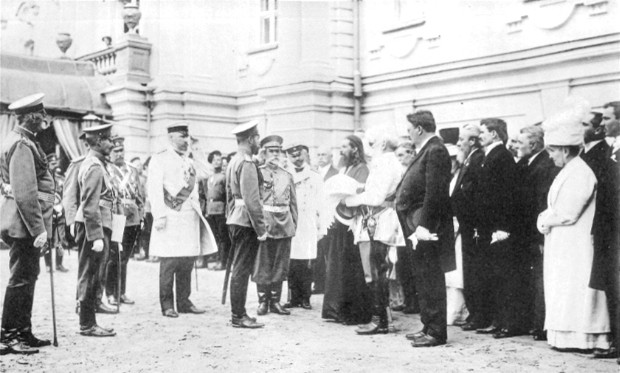Kyiv Club of Russian Nationalists
Kyiv Club of Russian Nationalists (Russian: Клуб русских националистов; Klub russkikh natsionalistov). A political and cultural organization established in 1908 to promote Russian national consciousness in the western borderlands of the Russian Empire and to defend Russian interests against ‘Polish pressure and Ukrainophilism.’ Headed by such noted Ukrainophobes as A. Savenko, Professor Timofii Florinsky, Vitalii Shulgin, I. Rakovich, and Dmitrii Pikhno, the publisher of the Russian nationalist newspaper Kievlianin and a member of the State Duma, the club became one of the most powerful pressure groups in the Russian Empire owing to the unusually energetic political activity of its leadership and the social prominence of its members.
At its height, it numbered some 700 members, largely drawn from the Russian and Russified elite of Kyiv. The club also cultivated a wide range of contacts with other conservative organizations and leaders throughout the empire, such as M. Menshikov, the influential columnist for the Saint Petersburg Novoe vremia and founder of the All-Russian National Union; Count A. Bobrinsky, president of the Congress of United Nobility; and Count V. Bobrinsky, head of the Saint Petersburg–based Galician-Russian Society.
From its inception, the Kyiv Club of Russian Nationalists devoted considerable attention to Duma and local politics and was regarded as a relatively moderate element within the spectrum of Russian nationalist organizations because of its willingness to work within the new constitutional framework. The Nationalist party, founded in 1909 and a leading force in the Third and Fourth State Dumas, was dominated by club members and their concerns. In 1909–12 the club lobbied to increase the political and economic positions of Russians in Right-Bank Ukraine and Belarus and actively campaigned to restrict, by law, Jewish participation in trade and local politics.
The Kyiv Club stood at the fore front of the struggle against the Ukrainian national movement before 1917. One of its first actions was a motion condemning the 1908 Duma bill to introduce Ukrainian as a language of instruction in elementary schools. Club leaders like Savenko and Florinsky always drew a sharp distinction, however, between the ‘Mazepists,’ ie, the Ukrainian intelligentsia, and the Ukrainian masses, considering the latter to be essentially loyal constituents of the all-Russian nation. Through its publications and lecture program, as well as articles in the newspaper Kievlianin and in Novoe vremia, the club attempted to raise public awareness concerning the dangers of the Ukrainian movement, which it viewed as a Polish-Austrian-German-Jewish intrigue. Kyiv Club members also worked behind the scenes, with some success, to pressure the administration to close down Ukrainian organizations (the Kyiv Ukrainian Club, 1912) and periodicals, such as Rada (Kyiv) (1914), and to prevent any public commemoration of the 50th anniversary of Taras Shevchenko’s death (1911) or the 100th anniversary of the poet’s birth (1914). The government decision to shut down all Ukrainian institutions in January 1915 was the culmination of this campaign.
From 1909 to 1914 the club published five volumes of Sbornik kluba russkikh natsionalistov (Collection of the Club of Russian Nationalists). During the First World War, it gradually lapsed into inactivity, though formally the club continued to exist until 1917.
BIBLIOGRAPHY
Storozhenko, A. Proiskhozhdenie i sushchnost' Ukrainofil'stva (Kyiv 1912)
Chykalenko, Ie. Shchodennyk, 1907–1917 (Lviv 1931)
Edelman, R. Gentry Politics on the Eve of the Russian Revolution: The Nationalist Party, 1907–1977 (New Brunswick, NJ 1980)
Olga Andriewsky
[This article originally appeared in the Encyclopedia of Ukraine, vol. 2 (1988).]

.jpg)